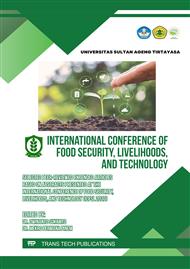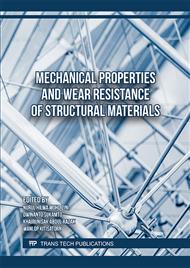[1]
E.A.S.Y.E. Widagdo, Y. Zaika, "Pengaruh Lama Waktu Curing Terhadap Nilai CBR Dan Swelling Pada Tanah Lempung Ekspansif Di Bojonegoro Dengan Campuran 6% Abu Sekam Padi Dan 4% Semen," p.1–8, 2017.
DOI: 10.31602/jk.v6i1.11648
Google Scholar
[2]
M. PUPR, "SE No. 04/SE/Db/2017 Tentang Penyampaian Manual Desain Perkerasan Jalan Revisi 2017 Di Lingkungan Direktorat Jenderal Bina Marga," J. Vis. Lang. Comput., vol. 11, no. 1, p.1–234, 2017.
DOI: 10.32511/juteks.v5i1.641
Google Scholar
[3]
L. Liu, A. Zhou, Y. Deng, Y. Cui, Z. Yu, and C. Yu, "Strength performance of cement/slag-based stabilized soft clays," Constr. Build. Mater., vol. 211, p.909–918, 2019.
DOI: 10.1016/j.conbuildmat.2019.03.256
Google Scholar
[4]
Y. Lu, S. Liu, Y. Zhang, Z. Li, and L. Xu, "Freeze-thaw Performance of a Cement-Treated Expansive Soil," Cold Reg. Sci. Technol., vol. 170, 2020.
DOI: 10.1016/j.coldregions.2019.102926
Google Scholar
[5]
M. Ghadakpour, A. J. Choobbasti, and S. S. Kutanaei, "Investigation of the Kenaf fiber hybrid length on the properties of the cement-treated sandy soil," Transp. Geotech., vol. 22, 2020.
DOI: 10.1016/j.trgeo.2019.100301
Google Scholar
[6]
O. Amini and M. Ghasemi, "Laboratory study of the effects of using magnesium slag on the geotechnical properties of cement stabilized soil," Constr. Build. Mater., vol. 223, p.409–420, 2019.
DOI: 10.1016/j.conbuildmat.2019.07.011
Google Scholar
[7]
B. K. Lumikis, S. Monintja, S. Balamba, and A. N. Sarajar, "Korelasi Antara Tegangan Geser Dan Nilai CBR Pada Tanah Lempung Ekspansif Dengan Bahan Campuran Semen," J. Sipil Statik, vol. 1, no. 6, p.400–407, 2013.
DOI: 10.24912/jmts.v2i2.4295
Google Scholar
[8]
A. Ravi, H. 'Ain, B. S. E. Polonia, and M. H. Faisal, "ANALYSIS OF LATERITE SOIL WITH PORTLAND CEMENT MIXED VARIATIONS AND THE EFFECT ON THE CBR UNSOAKED," J. Gradasi Tek. Sipil, vol. 5, no. 2, p.60–73, 2021.
DOI: 10.31961/gradasi.v5i2.1205
Google Scholar
[9]
D. Barbero, L. Serraiocco, A. Maroni, and S. Peyrot, "A Laboratory Methodological Proposal for ' Geotechnical Lime Stabilization of A-4 Soils ,'" vol. 8, no. 1, p.1–11, 2021.
Google Scholar
[10]
W. Kuswaya, W. Marsiano, S. Syafalni, and Jonbi, "Jambi and Palembang clay soil stabilization for pavement matrix in road construction by using Portland cement type I," MATEC Web Conf., vol. 276, p.05005, 2019.
DOI: 10.1051/matecconf/201927605005
Google Scholar
[11]
J.G. Eman, J.R. Sumampouw, and T.A.E, "Tanah Lempung Dengan Bahan Campuran Semen," J. Sipil Statik, vol. 5, no. 5, p.263–271, 2017.
Google Scholar
[12]
W. Fathonah, E. Mina, R. . Kusuma, and D. Damari, "Kinerja Semen Portland Komposit Sebagai Stabilisator Subgrade dan Pengaruhnya Terhadap Nilai Kuat Tekan Bebas," J. Ilm. Rekayasa Sipil, vol. 19, no. 1, p.28–34, 2022.
DOI: 10.30630/jirs.v19i1.752
Google Scholar
[13]
S. Aman, Teknologi Beton dalam Praktek. Surabaya: Fakultas Tehnik ITS, 1994.
Google Scholar
[14]
Badan Standardisasi Nasional, "Cara Uji Analisis Ukuran Butir Tanah SNI 3423:2008," 2008.
Google Scholar
[15]
Badan Standarisasi Nasional, "Cara Uji Berat Jenis Tanah SNI 1964:2008," 2008.
Google Scholar
[16]
Badan Standarisasi Nasional, "Cara Uji Kepadatan Ringan untuk Tanah SNI 1742:2008," 2008.
Google Scholar
[17]
Badan Standardisasi Nasional, "Cara Uji Penentuan Batas Plastis dan Indeks Plastisitas Tanah SNI 1966:2008," 2008.
Google Scholar
[18]
Badan Standarisasi Nasional, "Cara Uji Penentuan Batas Cair Tanah SNI 1967:2008," 2008.
Google Scholar
[19]
Badan Standarisasi Nasional, "Metode Uji CBR Laboratorium SNI 1744:2012," Jakarta: Kementrian Pekerjaan Umum, Badan Penelitian dan Pengembangan PU, 2008.
Google Scholar
[20]
A. Andriani, R. Yuliet, and F. L. Fernandez, "Pengaruh Penggunaan Semen Sebagai Bahan Stabilisasi Pada Tanah Lempung Daerah Lambung Bukit Terhadap Nilai Cbr Tanah," J. Rekayasa Sipil, vol. 8, no. 1, p.29, 2012.
DOI: 10.25077/jrs.8.1.29-44.2012
Google Scholar



